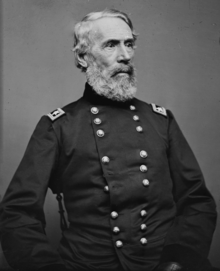Edwin Vose Sumner
Edwin Vose "bull's head" Sumner (born January 30, 1797 in Boston , Massachusetts , † March 21, 1863 in Syracuse , New York ) was an American major general in the US Army .
Early years and military advancement
Sumner's parents were Elisha Sumner and Nancy Voss. He attended West School, Billerica School, and then Milton Academy. He then began working as a merchant in Troy , New York. After he had given up his professional career as a businessman in 1819, he entered Troy as a lieutenant in the 2nd US Infantry Regiment. Sumner married Hannah Wickersham Foster on March 31, 1822, with whom he had six children. He spent the following decades until shortly before his death as an officer in the US Army. Sumner took part in the Black Hawk War and various other Indian wars . On March 4, 1833 he was promoted to captain and assigned to the 1st US Dragoons Regiment, which had just been reorganized by Congress. In 1838 he commanded the cavalry training camp in Carlisle , Pennsylvania . Sumner was the commandant of Fort Atkinson, Iowa from 1842 to 1845.
American-Mexican War
Edwin Sumner took part in the Mexican-American War as a major and was promoted to lieutenant colonel for his bravery in the Battle of Cerro Gordo . This is where he got his nickname: During the fighting, a musket ball is said to have ricocheted off his forehead. After the Battle of Molino del Rey Sumner became a brevet - Colonel promoted. On July 23, 1848 he was appointed deputy commander of the 1st US Dragoons Regiment. From 1851 to 1853 he was the military governor of the New Mexico Territory. On March 3, 1855, Sumner was appointed commander of the 1st US Cavalry Regiment. In this capacity he was given the status of Commandant of Fort Leavenworth , Kansas in 1856 . Sumner commanded an expedition against the Cheyenne in 1857 and was involved in the bloody clashes in the Kansas Territory. In 1858 he became commander in the western military area. His last assignment before the outbreak of the Civil War was to accompany the newly elected President Abraham Lincoln as senior officer.
American Civil War
When the Civil War broke out in 1861, Sumner had just been promoted to Brigadier General on March 16, 1861 , and was assigned to replace Albert S. Johnston as Commander of the Pacific Defense Area. For this reason he was not involved in the first campaigns of the war. Sumner was transferred to the east as a division commander and promoted to major general in the fall of 1861. Against Major General McClellan's will , the president put him in the reorganization of the Potomac Army as commanding general of II Corps . This corps was considered one of the best in the eastern theater of war. Sumner was the oldest general in the Potomac Army. He led the corps during the Peninsula Campaign and was wounded in the Battle of Glendale during the Seven Day Battle . He was later wounded again during the Battle of Antietam . When Ambrose Burnside took over command of the Potomac Army, he reorganized the corps into Grand Divisions and gave Sumner command of one of these new large formations. Sumner also took part in the Battle of Fredericksburg , which ended as a loss-making failure and inflicted heavy losses on his former II Corps in particular. Shortly thereafter, Sumner was released from his command at his own request and was to take over a new command in Missouri . He traveled home to Syracuse, New York, where he suffered a fatal heart attack on March 21, 1863. He was buried in Oakwood Cemetery in Syracuse.
various
Sumner was the oldest active commanding general on both sides during the Civil War.
Web links
- Edwin Sumner in the history of Kansas Territory (English)
- Edwin Vose Sumner in the database of Find a Grave (English)
| personal data | |
|---|---|
| SURNAME | Sumner, Edwin Vose |
| ALTERNATIVE NAMES | Sumner, bull head (nickname) |
| BRIEF DESCRIPTION | American major general in the US Army |
| DATE OF BIRTH | January 30, 1797 |
| PLACE OF BIRTH | Boston , Massachusetts |
| DATE OF DEATH | March 21, 1863 |
| Place of death | Syracuse , New York |

